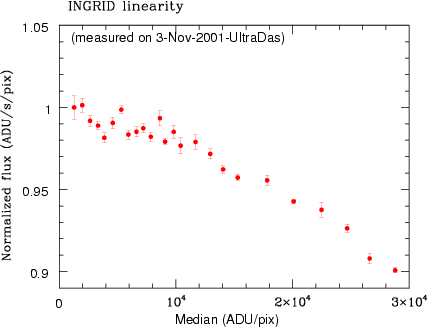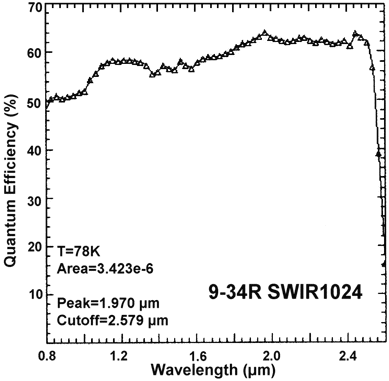 | |||
|
| Home > Astronomy > Detectors > INGRID |
Operational Characteristics
|
| |
|
| |
|
| see note 1 |
|
| see note 2 |
|
Noise (ADU) |
4.5 to 6.0 |
| see note 3 |
~2% (0 - 12000ADU) |
| |
|
- Apparent gain change dependent on pixel signal level occurs as an
intrinsic function of the device. As full well is approached, the gain tends
towards the lower value.
- Noise figures given for simple cds frame image readout. Noise can be
reduced by using multiple non-destructive readout (mndr) modes.
- An explanation of method is given here.
Binning
Not possible with this type of detector
Linearity plot

.
| Vertical CTE. | Not applicable with this type of detector. |
| Horizontal CTE | Not applicable with this type of detector. |
Physical Characteristics
| X Pixel size | 18.5 microns |
| Y Pixel size | 18.5 microns |
| X size in pixels of digitised area | 1024 |
| Y size in pixels of digitised area | 1024 |
| X size of useful imaging area | 1024 |
| Y size of useful imaging area | 1024 |
| X start of useful imaging area | 1 |
| Y start of useful imaging area | 1 |
| LN2 capacity of cryostats | Main cryostat 4.5 litre plus additional 2.5 litre cryostat in place of the closed cycle cooler |
| Pixel Scale Ingrid + Naomi |
0.04" per pixel |
| Field of view Ingrid +Naomi |
39" x 39" |
Operational Parameters
| Optimum operating temperature | 70K |
| Maximum operating temperature | 100K |
Measured characteristics
Quantum Efficiency (From Rockwell measurements)
~58% at J (1.2um) , ~58% at H(1.65um) , ~62% at (2.2um)

Note that the array does not cut off at 800nm. Sensitivity can still
be seen at 650nm !
| Dark current | 3e-/sec/pix @70K More info available here. |
| Full well bloom limit | 120,000 electrons |
| Hot pixels |
<1%. More info is available here. |
| Top | Back |
|

